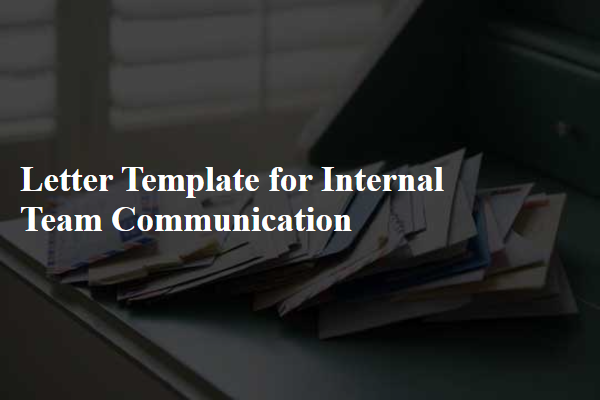Hey team! As we continue to strengthen our internal communications, I wanted to take a moment to share some insights and tips on crafting effective letters that can streamline our collaboration and foster a positive work environment. A well-written letter can convey important information clearly and help build stronger relationships within our team. So, if you're ready to enhance your communication skills and learn some best practices, join me in exploring this article!

Clear subject line
Subject lines in internal team communications serve as concise guides to the email's content and purpose. A clear subject line should include key details that reflect the main topic, date, and urgency. For example, an effective subject line might read: "Project Update: Q4 2023 Marketing Strategy Meeting on October 15." This format specifies the project (Marketing Strategy), identifies the quarter (Q4 2023), and mentions the exact meeting date (October 15), allowing team members to quickly assess its relevance and importance. Additionally, using terms like "Action Required" or "Reminder" can further emphasize urgency and ensure prompt attention from team members.
Concise message
Effective internal team communication enhances collaboration and productivity. Clear and concise messaging fosters understanding and alignment among team members. Regular updates on project milestones (such as quarterly goals or deadlines) can motivate progress and accountability. Utilizing tools like Slack or Microsoft Teams for discussions ensures timely feedback and reduces email overload. Establishing clear channels for communication (like weekly meetings or progress reports) helps streamline information sharing and minimizes confusion. Building a culture of open dialogue encourages team engagement and innovation, driving overall team success.
Defined objectives
Defined objectives play a crucial role in guiding teams towards success in various projects. Clear objectives, such as increasing revenue by 20% within the fiscal year 2024 or improving customer satisfaction scores by 15 points, provide measurable targets that can be assessed regularly. Specific goals, such as completing the development phase of a new software product by March 31, 2024, or launching a marketing campaign in New York City by June 15, 2024, help to focus efforts and allocate resources effectively. Additionally, outlining responsibilities for each team member--such as designating the project manager to track deadlines or assigning a data analyst to monitor performance metrics--creates accountability and promotes collaboration. Regular check-ins and progress reports ensure that all members stay aligned with the defined objectives, facilitating adjustments when necessary to improve outcomes.
Appropriate tone
Internal team communication requires clarity and professionalism. It's essential to convey messages respectfully while maintaining a collaborative spirit. Begin with a courteous greeting addressing the team or individual, followed by a clear and concise statement of purpose. Use straightforward language and avoid jargon unless necessary. Address specific topics or action items in organized bullet points if applicable, ensuring each point is easy to understand. Conclude with an expression of appreciation for the team's efforts or contributions, reinforcing unity and shared goals. Finally, sign off with a professional closing.
Call to action
In a fast-paced corporate environment, effective team communication is imperative. To enhance productivity, internal communications should serve as clear information conduits. Emphasizing action-oriented messages can energize team members, driving them towards specific goals. For instance, scheduling a strategy meeting on project XYZ for next Tuesday, October 10, 2023, at the main conference room, promotes collaboration and brainstorming. It's essential to specify that all team members should prepare progress reports, which delve into individual contributions and any obstacles faced during the past month. This structured approach not only fosters accountability but also reinforces a unified direction towards achieving quarterly targets, ultimately enhancing the overall efficiency of the team.













Comments